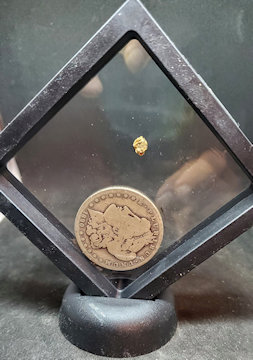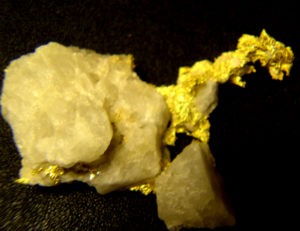Gold in San Diego California
California gold mining display at the natural history Museum in Balboa Park San Diego.
Many people do not realize that not only gold was mind in San Diego, but also San Diego has some major tourmaline mines.
Gold in San Diego
Julian California is about 50 miles East of San Diego.

Julian, California
Yes, there is still active tourmaline mines in San Diego County and a couple of small-scale gold-mining operations. But, just east of San Diego Imperial County, there is an active gold mine that’s been in operation for a number of years, and currently is running 24/7. Recreational gold prospecting, or gold-mining is a great hobby and a terrific way to see the backcountry and learn about the history of the area.
Some fine gems and specimen material have been produced in the United States, with the first discoveries in 1822, in the state of Maine. California became a large producer of tourmaline in the early 1900s. The Maine deposits tend to produce crystals in raspberry pink-red as well as minty greens. The California deposits are known for bright pinks, as well as bicolors. During the early 1900s, Maine and California were the world’s largest producers of gem tourmalines. The Empress Dowager Cixi of China loved pink tourmaline and bought large quantities for gemstones and carvings from the then new Himalaya Mine, located in San Diego County, California. It is not clear when the first tourmaline was found in California. Native Americans have used pink and green tourmaline as funeral gifts for centuries. The first documented case was in 1890 when Charles Russel Orcutt found pink tourmaline at what later became the Stewart Mine at Pala, California in San Diego County.
From Wikipedia, the free encyclopedia:
The first European settlers to arrive in this area were “Cockney Bill” Williams from England and John Wesley Horrell, who both arrived in the area in 1850 or 1851. The town itself was first settled by Drury, Frank, and J.O. Bailey, all brothers; and their cousins, Mike and Webb Julian. They were passing through the region from San Bernardino en route to Arizona in 1869, in the wake of the American Civil War. Taken by the beauty of the Julian area, Drury Bailey interrupted the group’s travel plans and chose instead to settle here; he chose to name the settlement “Julian” after Mike Julian because “Mike was better looking” than any other member of the Bailey family. Julian was also a former Confederate soldier who was later elected San Diego County Assessor. Shortly afterwards gold was discovered in the Julian region. A tent city initially formed in the boomtown, followed by more permanent structures as it became apparent that gold mining in Julian would persist for some time. Victorian-style structures were constructed in the latest stage of Julian’s early settlement, including the Hoskins House.
After the American Civil War, in 1869, A.E. “Fred” Coleman, a former slave, crossed over what is now known as Coleman Creek just west of Julian. Seeing a glint of gold in the stream bed, he climbed down from his horse to investigate. Having had previous experience in the gold fields, he retrieved his frying pan and began panning the sands of the creek. Soon thereafter, Coleman established the Coleman Mining District and was its recorder and also began the mining camp called Emily City, later renamed Coleman City. Learning of the find, others rushed to the district and tried to trace the gold to its source. On February 22, 1870, the first “lode”, or hard rock, mining claim was filed in the Julian area. Since February 22 was President George Washington’s birthday, the mine was named the Washington mine. Soon hundreds of anxious men and families rushed to Julian to stake their claims. Julian experienced a gold rush and became a tent city overnight. In April 1870, the area’s first sawmill was set up and Julian began to take on a more permanent structure. Attempts to build rival mining towns at Coleman City, Branson City and Eastwood were defeated. Owners of the Cuyamaca rancho Land Grant claimed (the Cuyamaca Land Float) Julian, and its mines were within the Rancho boundaries. In 1873, the courts ruled that the Rancho did not include Julian and the mines. While the miners tried to wrestle the gold from deep within the earth, James Madison brought a wagon load of young apple trees into the mountains. The fruit trees flourished in the clear, fresh air. Apples are still a big product in Julian, many of which are used for making the world-famous Julian apple pies.Local historians have variably suggested that the Julian of 1873 rivaled San Diego in population and they unsuccessfully attempted to shift the county seat to the city.
Gold in San Diego
#######
Visit our site to view real gold nuggets and prospecting equipment:
https://california-gold-rush-miner.us
Be sure to view our Gold nuggets for sale.
View our Natural Silver specimens, Visit our Old West Collections & Unique & Unusual page

Part of our Old West Collection ‘Silver & Gold’ -Gold nugget & Morgan silver dollar in display frame – A real super unique gift!
Also see the most expensive type of gold nuggets, the Crystalline Gold Nuggets

Crystalline gold
Subscribe to our Youtube Arizona Gold Prospecting channel
0 Comments